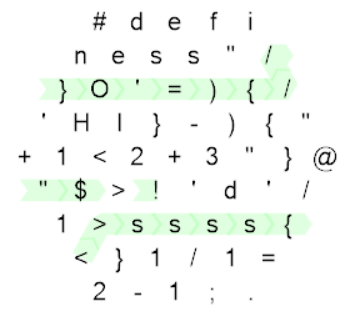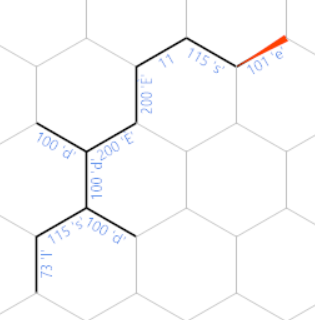A repost of this challenge. Meta discussion. Sandbox post. Body of the question similar to the original
This cops and robbers is now (08/03/2018) closed to further competing cop entries, as robbers may no longer be competing to crack answers, but feel free to post new answers.
The Cops challenge was won by Dennis with his brilliant 6 byte Sesos answer
The Robbers challenge was won by totallyhuman, with an astounding 30 cracks!
The Cops' Challenge
To compete as a cop:
Choose a programming language. A valid programming language is one which meets all three of these criteria:
- It has an English Wikipedia article, an esolangs article or a Rosetta Code article at the time this challenge was posted, or is on Try It Online!. Having an interpreter linked in any of these pages makes that interpreter completely legal.
- It must satisfy our rules on what constitutes a programming language
- It must have a free interpreter (as in beer). Free here means that anyone can use the program without having to pay to do so.
Write a full program that outputs the numbers from 1 to 100, inclusive, in ascending order. You can output as decimal integers, as bytecode values (
!to represent 33, for instance), or as unary digits (1111for 4, e.g)1. If using unary, you should use any consistent character for digits, and a different, consistent character as a delimiter. If using integers, you should output with a constant non-digit delimiter between each number. You may also output with leading and trailing characters (such as[]) but please be sensible (don't output a thousand bytes of rubbish either side of the count for instance). You must specify your output format in your answer.You must not assume a REPL environment or existing boilerplate code. Flags may be used, but you must reveal what flags are used in your answer. The program must be in the form of one or more source files (to rule out quirky languages like Folders) and must fit into your answer in full (so it must not be longer than 65,536 characters) - this shouldn't be an issue for any serious submission.
If your code contains bytes outside of printable ASCII + newline, please include a hex dump to make sure your code is actually testable.
The program must terminate within 5 minutes on a typical desktop PC.
That's it. However, as with everything, there is a catch. You should aim to obfuscate your program as much as possible, as the Robbers' task is to guess the language you used. You should also aim to make sure that your program only works in the intended language (although this is likely to be less of a problem than the Foo cracks in the original challenge). The output format must be the same as your intended solution in order to constitute a valid crack.
Once 7 days have passed without anyone discovering any language where your program is a valid crack, you may reveal the language and mark it as safe. Please note, your submission can still be cracked until you reveal the language.
You must not under any circumstances edit the source code of your submission once posted (as this may invalidate a robber's active attempts at cracking your answer). So make sure that you golf it as well as you can (or dare) before posting. If you realise that your answer does not work after posting it, simply delete your answer and post a fixed version if you want to.
The shortest safe submission in bytes wins!
1: If you wish to output in a different way, please ask in the comments
The Stack Snippet
You can use this stack snippet to browse the answers more easily:
answersSafe=[];answersCracked=[];answersUncracked=[];answerPage=1;robberTodo=[];userNames={};robberMap={};robberStats={};robberTimes={};function template($element,data){var $clone=$element.clone().removeClass('template');var html=$clone.html();for(var key in data){html=html.replace('{'+key+'}',data[key])}$clone.html(html);$element.after($clone)}function hideEmpty(){$('tbody').each(function(){if($(this).find('tr:not(.template):has(td)').length==0){$(this).find('tr:not(.empty):has(th)').addClass('inactive');$(this).find('tr.empty').removeClass('inactive')}})}function formatError(obj,reason){template($('.warn.template'),{id:obj.cop_id,cop:obj.cop_user,reason:reason})}function showAnswers(category,selector,sorter){sorter(category);$('#'+selector).find('tr:not(.template):has(td)').remove();$.each(category,function(i,answer){template($('#'+selector+' .template'),answer)});$('code:has(br)').addClass('clickable').click(function(){$(this).toggleClass('full')});updateCountdowns()}function getAnswers(){$.ajax({url:"https://api.stackexchange.com/2.2/questions/155018/answers?pagesize=100&order=desc&sort=creation&site=codegolf&filter=!*LUzJZNOIUpZsWsZBLe&page="+(answerPage++),method:"get",dataType:"jsonp"}).then(function(data){$.each(data.items,function(i,answer){var obj={cop_id:answer.answer_id,cop_user:answer.owner.display_name,cop_time:answer.creation_date,safe_on:answer.creation_date+604800};var $e=$('<div/>').html(answer.body);var $headers=$e.find(':header');if($headers.length==0){return formatError(obj,"no header")}var header=$headers.first().html();var $code=$e.find('pre code');if($code.length==0){return formatError(obj,"no code")}obj.code=$code.first().html().replace(/\n/g,'<br/>');if(obj.code.endsWith('<br/>')){obj.code=obj.code.slice(0,-5)}var bm=/(\d+)\s+bytes/.exec(header);if(bm==null){return formatError(obj,"no bytecount")}obj.size=parseInt(bm[1]);if(obj.size==NaN){return formatError(obj,"bytecount is NaN: "+bm[1])}obj.language=header.slice(0,bm.index).trim();while(obj.language.charAt(obj.language.length-1)!=','&&obj.language.length!=0){obj.language=obj.language.slice(0,-1)}if(obj.language.length==0){return formatError(obj,"no/bad separator before bytecount")}obj.language=obj.language.slice(0,-1).trim();obj.language_text=$('<div/>').html(obj.language).text();var end=header.slice(bm.index+bm[0].length).trim();if(end.length==0){if(obj.language!=="???"){return formatError(obj,"not marked as safe nor cracked, but language is "+obj.language+" (expected ???)")}return answersUncracked.push(obj)}if(!end.startsWith(',')){return formatError(obj,"no/bad separator after bytecount")}end=end.slice(1).trim();if(end==='safe'){return answersSafe.push(obj)}var $end=$('<div/>').html(end);var end_text=$end.text();if(!end_text.startsWith('cracked')){return formatError(obj,"expected 'cracked' or 'safe', got '"+end_text+"'")}var expectedURL='https://codegolf.stackexchange.com/a/';var $links=$end.find('a');if($links.length==0){return formatError(obj,"no cracked link")}var robberURL=$links.first().attr('href');if(!robberURL.startsWith(expectedURL)){return formatError(obj,"link does not start with "+expectedURL+": "+robberURL)}obj.robber_id=parseInt(robberURL.slice(expectedURL.length));if(obj.robber_id==NaN){return formatError(obj,"robber_id is NaN")}robberTodo.push(obj.robber_id);answersCracked.push(obj)});if(data.has_more){getAnswers()}else{getRobbers()}})}function sortBySize(category){category.sort(function(a,b){return b.size-a.size})}function sortByTime(category){category.sort(function(a,b){return b.cop_time-a.cop_time})}function sortByLiveTime(category){category.sort(function(a,b){return b.cracked_after-a.cracked_after})}function sortByCop(category){category.sort(function(a,b){return b.cop_user.localeCompare(a.cop_user)})}function sortByRobber(category){category.sort(function(a,b){return b.robber_user.localeCompare(a.robber_user)})}function sortByLanguage(category){category.sort(function(a,b){return b.language_text.localeCompare(a.language_text)})}function getRobbers(){if(robberTodo.length==0){$.each(answersCracked,function(i,answer){answer.robber_user=userNames[robberMap[answer.robber_id]];answer.cracked_after=robberTimes[answer.robber_id]-answer.cop_time;answer.cracked_after_str=formatTime(answer.cracked_after)});showAnswers(answersUncracked,'uncracked',sortByTime);showAnswers(answersCracked,'cracked',sortByLiveTime);showAnswers(answersSafe,'safe',sortBySize);hideEmpty();var graphData=[];$.each(robberStats,function(k,v){graphData.push({name:decodeEntities(userNames[k]),value:v})});graphData.sort(function(a,b){if(a.value==b.value){return a.name.localeCompare(b.name)}else{return b.value-a.value}});var graphLabels=[];var graphValues=[];$.each(graphData,function(i,obj){graphLabels.push(obj.name);graphValues.push(obj.value)});var graphColors=[];for(var i=0;i<graphData.length;i+=1){graphColors.push(['#b58900','#cb4b16','#dc322f','#d33682','#6c71c4','#268bd2','#2aa198','#859900'][i%8])}$('#robber-stats').attr('width',600);$('#robber-stats').attr('height',24*graphData.length+66);$('#answer-stats').attr('width',600);$('#answer-stats').attr('height',400);Chart.defaults.global.defaultFontColor='#839496';new Chart($('#robber-stats'),{type:'horizontalBar',data:{labels:graphLabels,datasets:[{data:graphValues,backgroundColor:graphColors}]},options:{responsive:false,legend:false,tooltips:false,layout:{padding:{right:40}},title:{display:true,text:'Number of answers cracked per robber',fontSize:18},scales:{yAxes:[{gridLines:{display:false}}],xAxes:[{gridLines:{display:false},ticks:{beginAtZero:true}}]},plugins:{datalabels:{anchor:'end',align:'end'}}}});new Chart($('#answer-stats'),{type:'pie',data:{labels:['Uncracked','Cracked','Safe'],datasets:[{data:[answersUncracked.length,answersCracked.length,answersSafe.length],backgroundColor:['#2aa198','#dc322f','#859900'],borderColor:'#002b36'}]},options:{responsive:false,tooltips:{backgroundColor:'#073642',displayColors:false},title:{display:true,text:'Number of answers in each category',fontSize:18},plugins:{datalabels:false}}});updateCountdowns();setInterval(updateCountdowns,1000);$('#loading').hide()}else{$.ajax({url:"https://api.stackexchange.com/2.2/answers/"+robberTodo.slice(0,100).join(';')+"?site=codegolf&filter=!*RB.h_b*K*dQTllFUdy",method:"get",dataType:"jsonp"}).then(function(data){$.each(data.items,function(i,robber){robberTodo=robberTodo.filter(function(e){return e!==robber.answer_id});robberMap[robber.answer_id]=robber.owner.user_id;robberTimes[robber.answer_id]=robber.creation_date;userNames[robber.owner.user_id]=robber.owner.display_name;if(robber.owner.user_id in robberStats){robberStats[robber.owner.user_id]+=1}else{robberStats[robber.owner.user_id]=1}});getRobbers()})}}var decodeEntities=(function(){var element=document.createElement('div');function decodeHTMLEntities(str){if(str&&typeof str==='string'){str=str.replace(/<script[^>]*>([\S\s]*?)<\/script>/gmi,'');str=str.replace(/<\/?\w(?:[^"'>]|"[^"]*"|'[^']*')*>/gmi,'');element.innerHTML=str;str=element.textContent;element.textContent=''}return str}return decodeHTMLEntities})();function formatTime(seconds){var arr=[];if(seconds>86400){arr.push(Math.floor(seconds/86400)+" days");seconds%=86400}if(seconds>3600){arr.push(Math.floor(seconds/3600)+" hours");seconds%=3600}if(seconds>60){arr.push(Math.floor(seconds/60)+" minutes");seconds%=60}if(seconds!=0){arr.push(seconds+" seconds")}return arr.join(', ').split('').reverse().join('').replace(',','dna ').split('').reverse().join('')}function updateCountdowns(){$('tr:not(.template) .countdown').each(function(){var target=$(this).attr('data-target');var now=Math.floor(+new Date()/1000);if(target-now<86400){$(this).addClass('urgent')}else{$(this).removeClass('urgent')}if(target<now){$(this).removeClass('countdown').text('Safe! (according to your computer\'s time)')}else{$(this).text(formatTime(target-now))}})}$('thead, #stats-header').click(function(){$(this).toggleClass('hidden')});getAnswers();*{margin:0;padding:0;font:12pt sans-serif;}html,body{background:#002b36;color:#839496;width:100%;height:100%;}body>:not(.i):not(#loading){margin:5px;}#loading{background:rgb(64,64,64,0.8);position:fixed;top:0;left:0;width:100%;height:100%;display:table;z-index:100;}#loading-wrapper{display:table-cell;vertical-align:middle;text-align:center;font-size:20pt;color:#ddd;}#fullpage-msg,.warn{padding:5px 5px 5px 5px;margin:10px 0px;}@media (min-width:800px){#fullpage-msg{display:none;}}a{color:#268bd2;}code{font-family:monospace;font-size:16px;background:#073642;padding:1px 5px;white-space:pre;position:relative;}.clickable{cursor:pointer;}code:not(.full){max-height:38px;overflow:hidden;}code.clickable:not(.full):before{content:'';background:linear-gradient(transparent 20px,rgba(7,54,66,0.8) 32px,#002b36);position:absolute;top:0;left:0;width:100%;height:100%;}td,th{padding:5px;vertical-align:top;white-space:nowrap;text-align:left;}thead th,#stats-header{font-size:20pt;margin:10px 0;user-select:none;-ms-user-select:none;-moz-user-select:none;-webkit-user-select:none;cursor:pointer;}th{font-weight:bold;}path{fill:#839496;}thead:not(.hidden) .right-arrow,#stats-header:not(.hidden) .right-arrow,thead.hidden .down-arrow,#stats-header.hidden .down-arrow{visibility:hidden;}.hidden+tbody,.hidden+#stats,.template,.inactive{display:none;}small,code{display:block;}small,small a{font-size:8pt;}#stats-header{font-weight:bold;padding:6px;}.urgent{color:#dc322f;}<script src="https://cdnjs.cloudflare.com/ajax/libs/jquery/3.3.1/jquery.min.js"></script><script src="https://cdnjs.cloudflare.com/ajax/libs/Chart.js/2.7.1/Chart.min.js"></script><script>!function(t,e){"object"==typeof exports&&"undefined"!=typeof module?e(require("chart.js")):"function"==typeof define&&define.amd?define(["chart.js"],e):e(t.Chart)}(this,function(t){"use strict";var e=(t=t&&t.hasOwnProperty("default")?t.default:t).helpers,n={toTextLines:function(t){var n,a=[];for(t=[].concat(t);t.length;)"string"==typeof(n=t.pop())?a.unshift.apply(a,n.split("\n")):Array.isArray(n)?t.push.apply(t,n):e.isNullOrUndef(t)||a.unshift(""+n);return a},toFontString:function(t){return!t||e.isNullOrUndef(t.size)||e.isNullOrUndef(t.family)?null:(t.style?t.style+" ":"")+(t.weight?t.weight+" ":"")+t.size+"px "+t.family},textSize:function(t,e,n){var a,r=[].concat(e),i=r.length,o=t.font,l=0;for(t.font=n.string,a=0;a<i;++a)l=Math.max(t.measureText(r[a]).width,l);return t.font=o,{height:i*n.lineHeight,width:l}},parseFont:function(a){var r=t.defaults.global,i=e.valueOrDefault(a.size,r.defaultFontSize),o={family:e.valueOrDefault(a.family,r.defaultFontFamily),lineHeight:e.options.toLineHeight(a.lineHeight,i),size:i,style:e.valueOrDefault(a.style,r.defaultFontStyle),weight:e.valueOrDefault(a.weight,null),string:""};return o.string=n.toFontString(o),o},bound:function(t,e,n){return Math.max(t,Math.min(e,n))}};function a(t,e){var n=e.x,a=e.y;if(null===n)return{x:0,y:-1};if(null===a)return{x:1,y:0};var r=t.x-n,i=t.y-a,o=Math.sqrt(r*r+i*i);return{x:o?r/o:0,y:o?i/o:-1}}function r(t,e,n,a,r){switch(r){case"center":n=a=0;break;case"bottom":n=0,a=1;break;case"right":n=1,a=0;break;case"left":n=-1,a=0;break;case"top":n=0,a=-1;break;case"start":n=-n,a=-a;break;case"end":break;default:r*=Math.PI/180,n=Math.cos(r),a=Math.sin(r)}return{x:t,y:e,vx:n,vy:a}}var i={arc:function(t,e,n){var a,i=(t.startAngle+t.endAngle)/2,o=Math.cos(i),l=Math.sin(i),s=t.innerRadius,d=t.outerRadius;return a="start"===e?s:"end"===e?d:(s+d)/2,r(t.x+o*a,t.y+l*a,o,l,n)},point:function(t,e,n,i){var o=a(t,i),l=t.radius,s=0;return"start"===e?s=-l:"end"===e&&(s=l),r(t.x+o.x*s,t.y+o.y*s,o.x,o.y,n)},rect:function(t,e,n,i){var o=t.horizontal,l=Math.abs(t.base-(o?t.x:t.y)),s=o?Math.min(t.x,t.base):t.x,d=o?t.y:Math.min(t.y,t.base),u=a(t,i);return"center"===e?o?s+=l/2:d+=l/2:"start"!==e||o?"end"===e&&o&&(s+=l):d+=l,r(s,d,u.x,u.y,n)},fallback:function(t,e,n,i){var o=a(t,i);return r(t.x,t.y,o.x,o.y,n)}},o=t.helpers;var l=function(t,e){this._el=t,this._index=e,this._model=null};o.extend(l.prototype,{_modelize:function(e,a,r,l){var s,d=this._index,u=o.options.resolve,f=n.parseFont(u([r.font,{}],l,d));return{align:u([r.align,"center"],l,d),anchor:u([r.anchor,"center"],l,d),backgroundColor:u([r.backgroundColor,null],l,d),borderColor:u([r.borderColor,null],l,d),borderRadius:u([r.borderRadius,0],l,d),borderWidth:u([r.borderWidth,0],l,d),color:u([r.color,t.defaults.global.defaultFontColor],l,d),font:f,lines:a,offset:u([r.offset,0],l,d),opacity:u([r.opacity,1],l,d),origin:function(t){var e=t._model.horizontal,n=t._scale||e&&t._xScale||t._yScale;if(!n)return null;if(void 0!==n.xCenter&&void 0!==n.yCenter)return{x:n.xCenter,y:n.yCenter};var a=n.getBasePixel();return e?{x:a,y:null}:{x:null,y:a}}(this._el),padding:o.options.toPadding(u([r.padding,0],l,d)),positioner:(s=this._el,s instanceof t.elements.Arc?i.arc:s instanceof t.elements.Point?i.point:s instanceof t.elements.Rectangle?i.rect:i.fallback),rotation:u([r.rotation,0],l,d)*(Math.PI/180),size:n.textSize(e,a,f),textAlign:u([r.textAlign,"start"],l,d)}},update:function(t,e,a){var r,i,l,s=null,d=this._index;o.options.resolve([e.display,!0],a,d)&&(r=a.dataset.data[d],i=o.valueOrDefault(o.callback(e.formatter,[r,a]),r),s=(l=o.isNullOrUndef(i)?[]:n.toTextLines(i)).length?this._modelize(t,l,e,a):null),this._model=s},draw:function(t){var e,a,r,i,l,s,d,u,f,h,c,y,g,x,b=this._model;b&&b.opacity&&(r=b.size,i=b.padding,l=r.height,s=r.width,u=-l/2,e={frame:{x:(d=-s/2)-i.left,y:u-i.top,w:s+i.width,h:l+i.height},text:{x:d,y:u,w:s,h:l}},a=function(t,e,n){var a=e.positioner(t._view,e.anchor,e.align,e.origin),r=a.vx,i=a.vy;if(!r&&!i)return{x:a.x,y:a.y};var o=e.borderWidth||0,l=n.w+2*o,s=n.h+2*o,d=e.rotation,u=Math.abs(l/2*Math.cos(d))+Math.abs(s/2*Math.sin(d)),f=Math.abs(l/2*Math.sin(d))+Math.abs(s/2*Math.cos(d)),h=1/Math.max(Math.abs(r),Math.abs(i));return u*=r*h,f*=i*h,u+=e.offset*r,f+=e.offset*i,{x:a.x+u,y:a.y+f}}(this._el,b,e.frame),t.save(),t.globalAlpha=n.bound(0,b.opacity,1),t.translate(Math.round(a.x),Math.round(a.y)),t.rotate(b.rotation),f=t,h=e.frame,y=(c=b).backgroundColor,g=c.borderColor,x=c.borderWidth,(y||g&&x)&&(f.beginPath(),o.canvas.roundedRect(f,Math.round(h.x)-x/2,Math.round(h.y)-x/2,Math.round(h.w)+x,Math.round(h.h)+x,c.borderRadius),f.closePath(),y&&(f.fillStyle=y,f.fill()),g&&x&&(f.strokeStyle=g,f.lineWidth=x,f.lineJoin="miter",f.stroke())),function(t,e,n,a){var r,i,o,l=a.textAlign,s=a.font.lineHeight,d=a.color,u=e.length;if(u&&d)for(r=n.x,i=n.y+s/2,"center"===l?r+=n.w/2:"end"!==l&&"right"!==l||(r+=n.w),t.font=a.font.string,t.fillStyle=d,t.textAlign=l,t.textBaseline="middle",o=0;o<u;++o)t.fillText(e[o],Math.round(r),Math.round(i),Math.round(n.w)),i+=s}(t,b.lines,e.text,b),t.restore())}});var s=t.helpers,d={align:"center",anchor:"center",backgroundColor:null,borderColor:null,borderRadius:0,borderWidth:0,color:void 0,display:!0,font:{family:void 0,lineHeight:1.2,size:void 0,style:void 0,weight:null},offset:4,opacity:1,padding:{top:4,right:4,bottom:4,left:4},rotation:0,textAlign:"start",formatter:function(t){if(s.isNullOrUndef(t))return null;var e,n,a,r=t;if(s.isObject(t))if(s.isNullOrUndef(t.label))if(s.isNullOrUndef(t.r))for(r="",a=0,n=(e=Object.keys(t)).length;a<n;++a)r+=(0!==a?", ":"")+e[a]+": "+t[e[a]];else r=t.r;else r=t.label;return""+r}},u=t.helpers,f="$datalabels";t.defaults.global.plugins.datalabels=d,t.plugins.register({id:"datalabels",afterDatasetUpdate:function(t,e,n){var a,r,i,o,s,d=t.data.datasets[e.index],h=(a=n,!1===(r=d.datalabels)?null:(!0===r&&(r={}),u.merge({},[a,r]))),c=e.meta.data||[],y=c.length,g=t.ctx;for(g.save(),i=0;i<y;++i)(o=c[i])&&!o.hidden?(s=new l(o,i)).update(g,h,{chart:t,dataIndex:i,dataset:d,datasetIndex:e.index}):s=null,o[f]=s;g.restore()},afterDatasetDraw:function(t,e){var n,a,r=e.meta.data||[],i=r.length;for(n=0;n<i;++n)(a=r[n][f])&&a.draw(t.ctx)}})});</script><div id="loading"><span id="loading-wrapper">Loading...</span></div><div id="fullpage-msg"><svg xmlns="http://www.w3.org/2000/svg" width="14" height="14" viewBox="0 0 111.577 111.577"><path d="M78.962,99.536l-1.559,6.373c-4.677,1.846-8.413,3.251-11.195,4.217c-2.785,0.969-6.021,1.451-9.708,1.451c-5.662,0-10.066-1.387-13.207-4.142c-3.141-2.766-4.712-6.271-4.712-10.523c0-1.646,0.114-3.339,0.351-5.064c0.239-1.727,0.619-3.672,1.139-5.846l5.845-20.688c0.52-1.981,0.962-3.858,1.316-5.633c0.359-1.764,0.532-3.387,0.532-4.848c0-2.642-0.547-4.49-1.636-5.529c-1.089-1.036-3.167-1.562-6.252-1.562c-1.511,0-3.064,0.242-4.647,0.71c-1.59,0.47-2.949,0.924-4.09,1.346l1.563-6.378c3.829-1.559,7.489-2.894,10.99-4.002c3.501-1.111,6.809-1.667,9.938-1.667c5.623,0,9.962,1.359,13.009,4.077c3.047,2.72,4.57,6.246,4.57,10.591c0,0.899-0.1,2.483-0.315,4.747c-0.21,2.269-0.601,4.348-1.171,6.239l-5.82,20.605c-0.477,1.655-0.906,3.547-1.279,5.676c-0.385,2.115-0.569,3.731-0.569,4.815c0,2.736,0.61,4.604,1.833,5.597c1.232,0.993,3.354,1.487,6.368,1.487c1.415,0,3.025-0.251,4.814-0.744C76.854,100.348,78.155,99.915,78.962,99.536z M80.438,13.03c0,3.59-1.353,6.656-4.072,9.177c-2.712,2.53-5.98,3.796-9.803,3.796c-3.835,0-7.111-1.266-9.854-3.796c-2.738-2.522-4.11-5.587-4.11-9.177c0-3.583,1.372-6.654,4.11-9.207C59.447,1.274,62.729,0,66.563,0c3.822,0,7.091,1.277,9.803,3.823C79.087,6.376,80.438,9.448,80.438,13.03z"/></svg> Click the "Full page" link in the top right for vastly superior experience</div><div class="warn template">⚠ <a href="https://codegolf.stackexchange.com/a/{id}">This answer</a> by {cop} is not formatted correctly ({reason}).</div><table><thead><tr><th colspan="5"><svg xmlns="http://www.w3.org/2000/svg" width="14" height="14" viewBox="0 0 9 9"><path class="right-arrow" d="M 0 0 L 0 9 L 9 4.5 Z"/><path class="down-arrow" d="M 0 0 L 9 0 L 4.5 9 Z"/></svg> Uncracked answers</th></tr></thead><tbody id="uncracked"><tr><th colspan="3" onclick="showAnswers(answersUncracked, 'uncracked', sortByCop)" class="clickable">Posted by</th><th onclick="showAnswers(answersUncracked, 'uncracked', sortBySize)" class="clickable">Size</th><th onclick="showAnswers(answersUncracked, 'uncracked', sortByTime)" class="clickable">Safe in</th><th>Code</th></tr><tr class="empty inactive"><th colspan="5">There are no uncracked answers</th></tr><tr class="template"><td colspan="3"><a href="https://codegolf.stackexchange.com/a/{cop_id}">{cop_user}</a></td><td>{size} bytes</td><td><span class="countdown" data-target="{safe_on}"></span></td><td><code>{code}</code></td></tr></tbody><thead><tr><th colspan="5"><svg xmlns="http://www.w3.org/2000/svg" width="14" height="14" viewBox="0 0 9 9"><path class="right-arrow" d="M 0 0 L 0 9 L 9 4.5 Z"/><path class="down-arrow" d="M 0 0 L 9 0 L 4.5 9 Z"/></svg> Cracked answers</th></tr></thead><tbody id="cracked"><tr><th onclick="showAnswers(answersCracked, 'cracked', sortByCop)" class="clickable">Posted by</th><th onclick="showAnswers(answersCracked, 'cracked', sortByRobber)" class="clickable">Cracked by</th><th onclick="showAnswers(answersCracked, 'cracked', sortByLanguage)" class="clickable">Language</th><th onclick="showAnswers(answersCracked, 'cracked', sortBySize)" class="clickable">Size</th><th onclick="showAnswers(answersCracked, 'cracked', sortByLiveTime)" class="clickable">Cracked after</th><th>Code</th></tr><tr class="empty inactive"><th colspan="5">There are no cracked answers</th></tr><tr class="template"><td><a href="https://codegolf.stackexchange.com/a/{cop_id}">{cop_user}</a></td><td><a href="https://codegolf.stackexchange.com/a/{robber_id}">{robber_user}</a></td><td>{language}</td><td>{size} bytes</td><td>{cracked_after_str}</td><td><code>{code}</code></td></tr></tbody><thead><tr><th colspan="5"><svg xmlns="http://www.w3.org/2000/svg" width="14" height="14" viewBox="0 0 9 9"><path class="right-arrow" d="M 0 0 L 0 9 L 9 4.5 Z"/><path class="down-arrow" d="M 0 0 L 9 0 L 4.5 9 Z"/></svg> Safe answers</th></tr></thead><tbody id="safe"><tr><th colspan="2" onclick="showAnswers(answersSafe, 'safe', sortByCop)" class="clickable">Posted by</th><th onclick="showAnswers(answersSafe, 'safe', sortByLanguage)" class="clickable">Language</th><th colspan="2" onclick="showAnswers(answersSafe, 'safe', sortBySize)" class="clickable">Size</th><th>Code</th></tr><tr class="empty inactive"><th colspan="5">There are no safe answers</th></tr><tr class="template"><td colspan="2"><a href="https://codegolf.stackexchange.com/a/{cop_id}">{cop_user}</a></td><td>{language}</td><td colspan="2">{size} bytes</td><td><code>{code}</code></td></tr></tbody></table><div id="stats-header"><svg xmlns="http://www.w3.org/2000/svg" width="14" height="14" viewBox="0 0 9 9"><path class="right-arrow" d="M 0 0 L 0 9 L 9 4.5 Z"/><path class="down-arrow" d="M 0 0 L 9 0 L 4.5 9 Z"/></svg> Statistics</div><div id="stats"><div><canvas id="robber-stats"/></div><div><canvas id="answer-stats"/></div></div><small>Snippet made by <a href="https://codegolf.stackexchange.com/u/55934/" target="_blank">NieDzejkob</a>, licensed as <a href="https://creativecommons.org/licenses/by-sa/3.0/" target="_blank">CC 3.0 BY-SA</a>. "Info" icon made by <a href="https://www.flaticon.com/authors/chanut" target="_blank">Chanut</a> from <a href="https://www.flaticon.com/" target="_blank">Flaticon</a>, licensed as <a href="http://creativecommons.org/licenses/by/3.0/" target="_blank">CC 3.0 BY</a>. "Arrow" icons made by <a href="https://codegolf.stackexchange.com/u/12012/" target="_blank">Dennis</a> for <a href="https://tio.run/" target="_blank">Try It Online</a>, licensed as <a href="https://github.com/TryItOnline/tryitonline/blob/master/LICENSE" target="_blank">MIT</a>. Some code shamelessly copy-pasted from <a href="https://stackoverflow.com/a/9609450">this answer</a> on Stack Overflow by <a href="https://stackoverflow.com/u/24950">Robert K</a>, licensed as <a href="https://creativecommons.org/licenses/by-sa/3.0/">CC 3.0 BY-SA</a>. This snippet utilises <a href="http://jquery.com/">jQuery</a> (<a href="https://github.com/jquery/jquery/blob/master/LICENSE.txt">MIT</a>), <a href="http://www.chartjs.org/">chart.js</a> (<a href="https://github.com/chartjs/Chart.js/blob/master/LICENSE.md">MIT</a>) and <a href="https://github.com/chartjs/chartjs-plugin-datalabels/">chartjs-plugin-datalabels</a> (<a href="https://github.com/chartjs/chartjs-plugin-datalabels/blob/master/LICENSE.md">MIT</a>). Color scheme: <a href="http://ethanschoonover.com/solarized">Solarized by Ethan Schoonover</a> (<a href="https://github.com/altercation/solarized/blob/master/LICENSE">MIT</a>).</small>Formatting
(Feel free to skip this section if you're not planning to participate as a cop)
This is required for new cop answers to make it possible for the snippet above to parse them.
New answers should include a header like this:
# ???, [N] byteswhere
[N]is the size of your code in bytes and???should appear literally.If the answer is not cracked for 7 days and you want to make your answer safe by revealing the language, simply replace the
???and addsafeto the end, e.g.# Ruby, [N] bytes, safeFeel free to have the language name link to a relevant website like an esolangs page or a GitHub repository. The link will then be displayed in the leaderboard.
If another user successfully cracked your submission, please also add the language, along with a notice like
# Ruby, [N] bytes, [cracked](crack-link) by [user]where
[user]is the name of the user who submitted the first valid crack, andcrack-linkis a link to the corresponding answer in the Robbers' thread. Please use the short link format you get from the "share" button. Feel free to make the user name a link to their profile page.If the language used in the crack is different from the one you intended, your answer is still cracked, and you shall follow this format. However, you can mention in the answer that you intended it to be something else. It's your choice on whether you want to reveal the intended answer, or if you want to let Robbers have more fun.
Good luck Cops!












